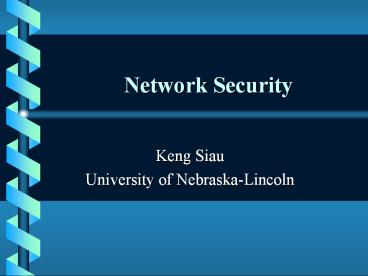Network Security - PowerPoint PPT Presentation
Title: Network Security
1
Network Security
- Keng Siau
- University of Nebraska-Lincoln
2
Components of Security Policy
- Describes items to be protected and rules for
protection - Must cover computer systems, LANs,
interconnection devices, Internet access, etc. - Development must include assessment of cost of
protected information versus cost of protection
3
Aspects of Security
- Data accessibility
- Contents accessible
- Data integrity
- Contents remain unchanged
- Data confidentiality
- Contents not revealed
4
Responsibility and Control
- Must be able to delegate and control
responsibility - Accountability
- Who is responsible for tracking access to data
- Authorization
- Who is responsible for who access data
5
Encryption and Privacy
- Encryption
- Rewrite contents so that they cannot be read
without key - Encrypting function
- Produces encrypted message
- Decrypting function
- Extracts original message
- Encryption key
- Parameter that controls encryption/decryption
sender and receiver share secret key
6
Encryption and Privacy
- Sender produces
- Encrypted Message encrypt(Key, Message)
- Sender transmits Encrypted Message on network
- Receiver extracts
- Message decrypt(Key, Encrypted Message)
- Requires sharing of secret Key
- If Key is discovered, security is compromised
7
Public Key Encryption
- Public key encryption uses two keys
- Private key
- Kept secret by user
- Public key
- Published by user
- To send a message to user 1
- Encrypt using User 1s public key
- User 1 decrypts using his/her private key
8
Authentication -- Digital Signatures
- Goal
- Guarantee that message must have originated with
certain entity - Idea
- Encrypt with private key
- Decrypt with public key
- Only owner of private key could have generated
original message
9
Authentication and Privacy
- Combine previous two techniques
- A sends a message to B
- X encrypt(PUB-B, encrypt(PRV-A, M))
- B extracts message
- M decrypt(PUB-A, decrypt(PRV-B, X))
10
Packet Filtering
- Can configure packet forwarding devices, e.g.,
routers, to drop certain packets - Consider example
- Suppose 192.5.48.0 is test network and 128.10.0.0
has controlling workstations - Install filter to allow packets only from
192.5.48.0 to 128.10.0.0 - Keeps potentially bad packets away from remainder
of Internet
11
Packet Filtering
12
Internet Firewall
- Packet filter at edge of intranet can disallow
unauthorized packets - Restricts external packets to just a few internal
hosts
13
Summary
- Security is a problem because Internet is not
owned by one entity - Organizations can use firewalls to prevent
unauthorized access - Encryption and digital signatures can provide
confidentiality and secure identification































